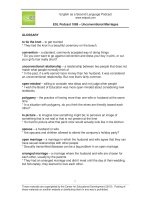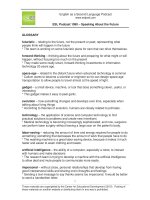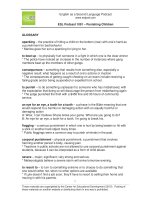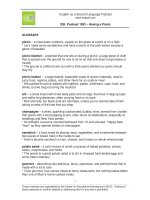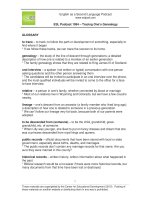ESLPod 1106 guide Want to be Fluent in English?
Bạn đang xem bản rút gọn của tài liệu. Xem và tải ngay bản đầy đủ của tài liệu tại đây (91.81 KB, 9 trang )
English as a Second Language Podcast
www.eslpod.com
ESL Podcast 1106 – Getting a Flat Tire
GLOSSARY
thumping – a heavy, loud, repetitive noise, like the sound of something heavy
hitting the ground again and again
* That thumping noise is just the sound of children playing in the apartment
above us.
flat tire – a tire that no longer has any air, usually because there is a small hole
that allowed the air to escape
* Try to drive around broken glass—not over it—or you might get a flat tire.
rear – back; not in the front
* Blake can sit up front with me, and Lyle and Julie can sit in the rear seats.
leak – a small hole that allows air or liquid to escape from a container or surface
* The roof has a small leak, so we put a bucket on the floor to catch the
rainwater.
to inflate – to fill something with air; to blow or pump air into something at high
pressure so that it increases in size
* How often do you have to inflate the basketballs?
gas station – a business where people go to buy gasoline and put it into their
vehicles
* We ran out of gas while driving, and had to walk two miles to the nearest gas
station.
to pull off to the side of the road – to park along the side of the road, where
cars do not normally drive, especially to fix one’s car or to take care of an
emergency
* It’s dangerous to drive while speaking on a cell phone. Please pull off to the
side of the road before making a call.
worn out – used fully or completely so that something needs to be replaced;
having no additional use
* Those tennis shoes are worn out, with broken laces and holes in the bottom.
Let’s buy you a new pair.
tread – the thick rubber part of a tire that grips (holds onto) the road and
gradually becomes thinner as the tire is used for a long period of time
* Some treads are better than others for slippery, wet roads.
1
These materials are copyrighted by the Center for Educational Development (2015). Posting of
these materials on another website or distributing them in any way is prohibited.
English as a Second Language Podcast
www.eslpod.com
ESL Podcast 1106 – Getting a Flat Tire
jack – a small tool that is placed under the frame of a car and used to raise it up
so that one can work underneath it, especially to change a tire
* I would never be able to lift a car by myself, but with this jack, I can pump the
handle and slowly lift the car.
spare tire – an extra tire, usually kept in the car’s trunk, that is used to replace a
flat tire when needed until a new tire can be purchased
* The spare tire is on, and should be fine to get you to the nearest mechanic’s
shop, where you can buy a new tire.
trunk – the area of a car used for storage, not for seating, usually found in the
back of a vehicle
* I just got back from the store. Can you help me unload the trunk? It’s full of
groceries.
wrench – a metal tool with a handle, used to turn bolts or nuts (small pieces of
metal used to hold larger pieces of material together)
* We’ll need a wrench to raise the bike seat.
lug nut – a large rounded nut (small piece of metal with a hole in the center) that
fits over a bolt (long piece of metal, similar to a thick screw, but without grooves),
especially one used to attach a tire to a car
* Make sure you tighten to lug nuts, but don’t make them so tight that we won’t
be able to remove them next time.
hazard lights – car lights that repeatedly flash on and off, used as a warning to
other drivers, especially because a car has temporarily parked in an unusual
spot, or because it is traveling more slowly than other cars on the road
* When a heavy tractor is traveling slowly on a highway, the driver should put on
hazard lights so that the other drivers take notice of it.
rim – the edge of the metal part of a wheel, which holds the rubber tire in place
* The bicycle tires kept running out of air. When we looked closely, we realized it
was because there was a sharp piece of metal on the rim of one of the wheels.
bent – having an angle or curve in something that should be straight, caused by
applying a strong force
* The children were playing with Grandma’s cane and bent it.
to bone up on – to study something intensively in a short period of time; to cram
* Too many students try to bone up on material right before an exam, rather than
studying a little bit every day throughout the semester.
2
These materials are copyrighted by the Center for Educational Development (2015). Posting of
these materials on another website or distributing them in any way is prohibited.
English as a Second Language Podcast
www.eslpod.com
ESL Podcast 1106 – Getting a Flat Tire
COMPREHENSION QUESTIONS
1.
a)
b)
c)
What did Minisa do the last time she was at the gas station?
She bought a new tire.
She put air into the tire.
She checked the tire.
2.
a)
b)
c)
Which of these tools can lift a car off the ground?
A jack
A wrench
Lug nuts
______________
WHAT ELSE DOES IT MEAN?
tread
The word “tread,” in this podcast, means the thick rubber part of a tire that grips
(holds onto) the road and gradually becomes thinner over time: “If the tread has
worn away, it’s probably time to buy new tires.” As a verb, “to tread” means to
step on something: “Careful! Don’t tread on those flowers.” The phrase “to tread
lightly” means to do something carefully or cautiously: “Her divorce is a sensitive
topic with Melinda, so tread lightly.” Finally, the phrase “to tread water” means to
keep one’s head above water and in one place by moving one’s legs underwater
as if riding a bicycle: “David doesn’t know how to swim well, but he can tread
water, so he won’t drown.”
bent
In this podcast, the word “bent” means having an angle or curve in something
that should be straight, caused by applying a strong force: “After the earthquake,
we could all see that the bridge supports were bent.” The word “bent” can also
refer to a body part that is folded rather than straight: “The runner stood with bent
knees, waiting for the race official to say ‘go.’” The phrase “bent out of shape”
means very upset or angry: “Damian was really bent out of shape about what you
said. He thinks you should apologize to him.” Finally, the phrase “bent on
(something)” means determined to do something and fully focused on it: “Sheila
is bent on buying that car, even if she can’t really afford it.”
3
These materials are copyrighted by the Center for Educational Development (2015). Posting of
these materials on another website or distributing them in any way is prohibited.
English as a Second Language Podcast
www.eslpod.com
ESL Podcast 1106 – Getting a Flat Tire
CULTURE NOTE
Roadside Assistance
Many Americans “rely on” (depend on; use the services of) “roadside
assistance,” programs to help them when they “run into trouble” (have problems)
“on the road” (while traveling). Many automobile insurance programs offer
roadside assistance programs as “add-on services” (something that is added to
the basic offering by paying an additional fee). Other people purchase roadside
assistance through a separate program, such as membership in the American
Automobile Association, or AAA (see ESL Podcast 49 and English Café 100).
A roadside assistance program offers “assistance” (help) to drivers who are
facing an “urgent” (needing something right away) problem. Drivers who have
problems can call a number to report the problem, and the program sends
someone to help them.
For example, drivers can call for help if they accidentally lock their keys in their
car, if they have a flat tire, if they have a “dead” (not working) “battery” (used to
get electricity), or if they run out of gas. The roadside assistance program will
send someone, usually within a short time, to “pick the lock” (open a locked
door), change the tire, “jump-start the battery” (apply cables connecting a
working car to a car with a dead battery, so that the car starts again), or “deliver”
(bring) a small amount of gasoline. If the car “breaks down” (stops working and
will no longer move forward), the roadside assistance program might provide free
“towing” (using a strong truck to pull another car) to the nearest “mechanic”
(someone whose job is to fix cars).
A roadside assistance program provides “peace of mind” (a sense of calm and
security, not needing to worry) to drivers, who are usually happy to “fork over”
(pay) a small monthly fee, even if they rarely or never use the service.
______________
Comprehension Questions Correct Answers: 1 – b; 2 – a
4
These materials are copyrighted by the Center for Educational Development (2015). Posting of
these materials on another website or distributing them in any way is prohibited.
English as a Second Language Podcast
www.eslpod.com
ESL Podcast 1106 – Getting a Flat Tire
COMPLETE TRANSCRIPT
Welcome to English as a Second Language Podcast number 1,106 – Getting a
Flat Tire.
This is English as a Second Language Podcast episode 1,106. I’m your host, Dr.
Jeff McQuillan, coming to you from the Center for Educational Development in
beautiful Los Angeles, California.
Go to our website at ESLPod.com or become a member of ESL Podcast. When
you do, you can download a Learning Guide for this episode that contains all of
the vocabulary, definitions, sample sentences, additional definitions, cultural
notes, and a complete transcript of everything we say.
This episode is a dialogue about driving your car and getting a flat tire. Let’s get
started.
[start of dialogue]
Jaloliddin: What is that thumping noise?
Minisa: I don’t hear anything.
Jaloliddin: I think you have a flat tire.
Minisa: The left rear tire has a slow leak, but I just inflated it the last time I was at
the gas station, so I’m sure it’s fine.
Jaloliddin: No, really, I think you need to pull off to the side of the road.
Minisa: We’re on a busy freeway, but if you insist.
Jaloliddin: Wow, your tire is definitely flat. See how the tire is completely worn
out, with hardly any tread left?
Minisa: Yeah, well, I’ve been meaning to get a new one. Now what?
Jaloliddin: We need to change it. Let’s see if you have a jack and a spare tire.
Minisa: I think they’re in the trunk, but I don’t think I could do it myself.
5
These materials are copyrighted by the Center for Educational Development (2015). Posting of
these materials on another website or distributing them in any way is prohibited.
English as a Second Language Podcast
www.eslpod.com
ESL Podcast 1106 – Getting a Flat Tire
Jaloliddin: [sigh] Right. I’ll change the tire. Do you have a wrench so I can get the
lug nuts off?
Minisa: I have some basic tools in the trunk, too, I think.
Jaloliddin: Put your hazard lights on and I’ll get to work. At least your rim doesn’t
look bent.
Minisa: I’m glad to hear that. What should I do?
Jaloliddin: Bone up on basic car maintenance?
[end of dialogue]
This episode is all about getting a “flat (flat) tire (tire).” A “flat tire” is when you
have a tire that no longer has any air in it, usually because there’s a small hole in
the tire. A tire, I guess I should explain, is what goes around the wheels of your
car. Most cars have four wheels, and around the wheels go tires. The tires
usually have air in them. If the tires don’t have any air, well, then the car will not
move very easily.
In our dialogue, Jaloliddin says to Minisa, “What is that thumping noise?”
“Thumping” (thumping) is an adjective used to describe a heavy, loud noise,
usually a sound made by something heavy hitting the ground or something else.
In this case, it’s the sound of rubber hitting the road with a flat tire. Minisa says, “I
don’t hear anything.”
Jaloliddin says, “I think you have a flat tire.” Minisa says, “The left rear tire has a
slow leak, but I just inflated it the last time I was at the gas station, so I’m sure it’s
fine. Minisa doesn’t think she has a problem at all. She does say that “the left
rear tire has a slow leak.” A car has front tires in the – well, logically – front of the
car as well as rear tires in the rear or back of the car. There’s a tire on the left
and the right side of both the front and the rear of the car.
So the “left rear tire” would be the tire in the back of the car on the left hand side.
Minisa says that the tire in the left rear “has a slow leak” (leak). A “leak” is when
you have a small hole in something that has either air or liquid in it, that allows
the air or liquid to escape, to go out of the container. If a tire has a “slow leak,” as
Minisa describes it, it means that air is slowly escaping from the tire, but not so
fast that the tire becomes flat.
6
These materials are copyrighted by the Center for Educational Development (2015). Posting of
these materials on another website or distributing them in any way is prohibited.
English as a Second Language Podcast
www.eslpod.com
ESL Podcast 1106 – Getting a Flat Tire
Minisa says she just inflated the tire the last time she was at the gas station. “To
inflate” (inflate) in this case means to put air into something. If your tire is flat, you
have to inflate it. You have to put more air into it. We might also say “blow up” the
tire. A “gas station” is a place where you buy gasoline for your car. Typically, gas
stations also have air pumps, which are machines that allow you to inflate a tire.
However, Jaloliddin says, “No, really, I think you need to pull off to the side of the
road.” “To pull off to the side of the road” means to take your car and park it
along the side of a road or a street so that you are not actually on the main part
of the road or street. Minisa says, “We’re on a busy freeway, but if you insist.”
Minisa is pointing out that they’re on a freeway, which is a special road where
people drive fast – at least, if they can.
She says, “But if you insist,” meaning if you absolutely think I must pull off to the
side of the road, then I will. At this point, the two of them get out of the car to take
a look at the tire and Jaloliddin says, “Wow, your tire is definitely flat. See how
the tire is completely worn out with hardly any tread left?” “To be worn (worn) out”
means to be used so completely that you can no longer use it. Something that is
worn out has to be replaced. It is no longer usable.
Minisa’s tire hardly has any “tread” (tread) left on it. The tread of a tire is the thick
rubber part that actually holds on to, or grips, the road. If you look at a tire, you
can see lines in the rubber of the tire, or the material the tire is made of. That’s
the “tread.” If you don’t see any lines, if the tire is basically smooth, we would say
that the tire is “bald” (bald). And you don’t want to drive with tires that are bald.
That can be dangerous because you won’t be able to stop easily or quickly if you
need to.
Minisa says, “Yeah, well I’ve been meaning to get a new one,” meaning she had
been planning on getting a new tire. Then she asks, “Now what?” meaning “What
do we do now?” Jaloliddin says, “We need to change it,” meaning to put a new
tire on, or a different tire on. “Let’s see if you have a jack and a spare tire.” Most
cars have a “spare (spare) tire,” which is an extra tire usually kept in the back of
the car, in the car’s trunk, that can be used if you get a flat tire. A “jack” (jack) is a
small tool that is used to lift the car up so you can take one of the tires off and put
a new one on.
We call it a “spare tire,” but it’s really a spare wheel and tire. The rubber tire goes
around the metal wheel. Minisa says, “I think they’re in the trunk,” meaning the
jack and the spare tire are in the trunk, “but I don’t think I could do it myself.” A
“trunk” (trunk) is the back part of a car, used for storing things. It’s not a place
7
These materials are copyrighted by the Center for Educational Development (2015). Posting of
these materials on another website or distributing them in any way is prohibited.
English as a Second Language Podcast
www.eslpod.com
ESL Podcast 1106 – Getting a Flat Tire
where you could actually sit. Well you could, I suppose, but it wouldn’t be very
comfortable. Minisa says, “I don’t think I could do it myself.”
Now, Jaloliddin follows the statement by sighing, as though he doesn’t really
want to do it either. I guess he’s not a very nice guy, huh? Anyway, he says, “I’ll
change the tire. Do you have a wrench so I can get the lug nuts off?” A “wrench”
(wrench) is a metal tool that is used to turn small pieces of metal called “nuts”
that are used to hold, in this case, the tire onto the car. A “lug (lug) nut” is what
we call the nuts that are used to hold the wheels onto the car. Minisa says, “I
have some basic tools in the trunk, too, I think.”
Jaloliddin says, “Put your hazard lights on and I’ll get to work.” Your “hazard
(hazard) lights” are lights on your car that go on and off – that we would say
“flash” on and off – to warn other drivers that you are parked or that there is
some sort of problem with your car. We’re guessing that this is Minisa’s friend
and not boyfriend or husband, because if it were a boyfriend or a husband and
he didn’t seem very enthusiastic about helping his girlfriend or wife, he probably
wouldn’t have a girlfriend or wife for much longer.
Anyway, in this case Jaloliddin says, “At least your rim doesn’t look bent.” The
“rim” (rim) is the edge of the wheel. It’s the part of the wheel that the tire goes
around. If something is “bent” (bent), it has an angle or a curve in it where it
shouldn’t. If your wheel is damaged – if you hit it, for example, against the side of
the road or against a curb or a rock – you could bend the rim in such a way that
you damage it. The rim should go around in a circle, and if there’s any break in
that circle, then we would say the rim is “bent.” It isn’t in the correct shape.
Minisa says, “I’m glad to hear that,” meaning I’m glad to hear that the rim of the
wheel is not bent. “What should I do?” she asks. Jaloliddin says, “Bone up on
basic car maintenance?” “To bone (bone) up on” something means to study
something for a short period of time – to try to learn something quickly. What
Jaloliddin is saying is that Minisa needs to learn how to change a tire so that she
doesn’t rely on other people – namely, him – to do it. I think you need a new
friend, Minisa.
Now let’s listen to the dialogue, this time at a normal speed.
[start of dialogue]
Jaloliddin: What is that thumping noise?
Minisa: I don’t hear anything.
8
These materials are copyrighted by the Center for Educational Development (2015). Posting of
these materials on another website or distributing them in any way is prohibited.
English as a Second Language Podcast
www.eslpod.com
ESL Podcast 1106 – Getting a Flat Tire
Jaloliddin: I think you have a flat tire.
Minisa: The left rear tire has a slow leak, but I just inflated it the last time I was at
the gas station, so I’m sure it’s fine.
Jaloliddin: No, really, I think you need to pull off to the side of the road.
Minisa: We’re on a busy freeway, but if you insist.
Jaloliddin: Wow, your tire is definitely flat. See how the tire is completely worn
out, with hardly any tread left?
Minisa: Yeah, well, I’ve been meaning to get a new one. Now what?
Jaloliddin: We need to change it. Let’s see if you have a jack and a spare tire.
Minisa: I think they’re in the trunk, but I don’t think I could do it myself.
Jaloliddin: [sigh] Right. I’ll change the tire. Do you have a wrench so I can get the
lug nuts off?
Minisa: I have some basic tools in the trunk, too, I think.
Jaloliddin: Put your hazard lights on and I’ll get to work. At least your rim doesn’t
look bent.
Minisa: I’m glad to hear that. What should I do?
Jaloliddin: Bone up on basic car maintenance?
[end of dialogue]
If you need to bone up on your English, there’s no better way than listening to the
wonderful dialogues written by the wonderful scriptwriter Dr. Lucy Tse.
From Los Angeles, California, I’m Jeff McQuillan. Thank you for listening. Come
back and listen to us again right here on ESL Podcast.
English as a Second Language Podcast was written and produced by Dr. Lucy
Tse, hosted by Dr. Jeff McQuillan. Copyright 2015 by the Center for Educational
Development.
9
These materials are copyrighted by the Center for Educational Development (2015). Posting of
these materials on another website or distributing them in any way is prohibited.
